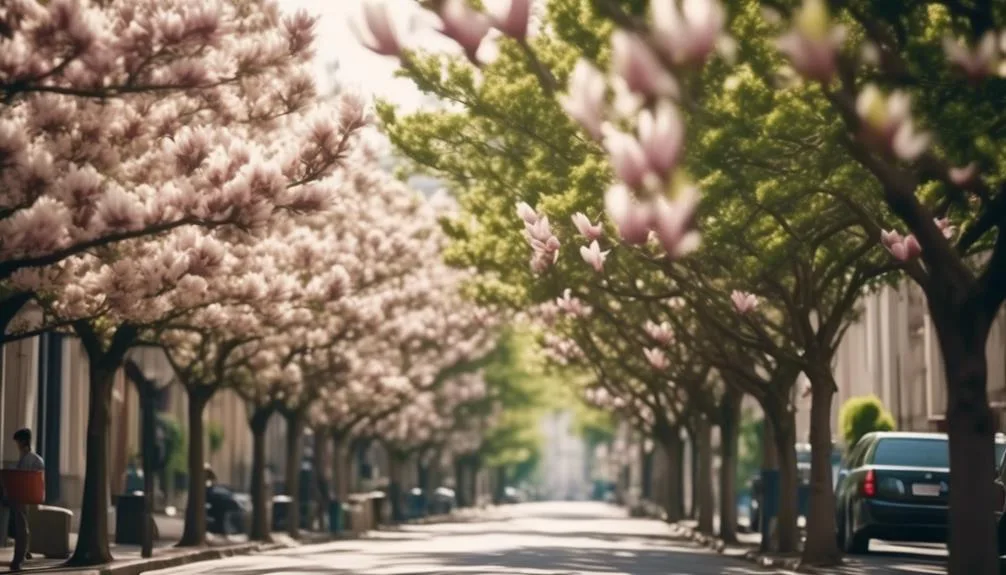Urban planting can be tough, especially when choosing trees. Magnolia trees are often considered for their beauty, but are they right for city life?
Let's explore if magnolia trees can thrive in urban environments and contribute to city ecosystems. We'll look at the factors that make them suitable and the things to consider when planting them in urban settings.
Urban Environment Considerations for Magnolia Trees
When planting magnolia trees in urban environments, it's crucial to consider the unique challenges and opportunities presented by the city landscape.
Firstly, soil quality is essential for the healthy growth of magnolia trees. Ensure the soil is well-draining and nutrient-rich to support their development.
Additionally, consider tree spacing to allow for adequate air circulation and prevent overcrowding.
Magnolia trees also need to exhibit pollution tolerance due to the urban environment. Look for varieties that can withstand air and soil pollution commonly found in cities.
Moreover, understanding the root growth of magnolia trees is crucial in urban settings. Their roots can be sensitive to compacted soil, so providing adequate space and considering root barriers can aid in their healthy development amidst urban challenges.
Magnolia Tree Varieties Suited for Urban Planting
To select magnolia tree varieties suitable for urban planting, consider their pollution tolerance, growth habit, and size requirements to ensure successful growth in the city landscape.
- Pollution Tolerance: Look for varieties such as Magnolia grandiflora and Magnolia stellata, known for their resilience to urban pollution. These species can thrive in challenging soil conditions and are less susceptible to damage from air pollutants.
- Size and Growth Habit: Choose compact cultivars like Magnolia 'Jane' or 'Ann' with a manageable height and spread. These varieties are suitable for smaller urban spaces and can be pruned to maintain their shape and size.
When planting magnolia trees in urban areas, ensure adequate tree spacing to accommodate their root systems and employ proper pruning techniques to maintain their health and aesthetic appeal.
Maintenance and Care of Magnolia Trees in Urban Settings
For successful growth and health of magnolia trees in urban settings, regular maintenance and care are essential. Proper pruning techniques and attention to soil quality can significantly impact the well-being of these trees. When it comes to pruning, it's crucial to remove dead or diseased branches to promote new growth and prevent the spread of diseases. Additionally, selectively thin out crowded branches to improve air circulation and reduce the risk of pest infestations. As for soil quality, urban environments often suffer from compacted soil, which can hinder the tree's growth. Consider aerating the soil and adding organic matter to improve drainage and nutrient availability. Here's a table summarizing key maintenance and care practices for magnolia trees in urban settings:
| Maintenance and Care Tips | |
|---|---|
| Pruning Techniques | Regularly inspect the tree for dead or diseased branches. Thin out crowded branches to improve air circulation. |
| Soil Quality | Aerate the soil to reduce compaction. Add organic matter to improve drainage and nutrient availability. |
Potential Challenges of Planting Magnolia Trees in Urban Areas
Planting magnolia trees in urban areas presents several potential challenges, including issues with limited space and air pollution affecting tree health. These challenges can impact the environmental impact of the trees and their ability to thrive in urban settings. Here are some key points to consider:
- Limited Root Space
- In urban areas, magnolia trees may struggle to find enough space for their roots to grow and spread, leading to restricted access to nutrients and water.
- Air Pollution
- Urban environments often have higher levels of air pollution, which can negatively affect the health of magnolia trees, leading to issues like leaf discoloration and reduced growth.
When considering planting magnolia trees in urban areas, it's important to address these challenges to ensure the long-term health and vitality of the trees.
Benefits of Planting Magnolia Trees in Urban Landscapes
Addressing the challenges of limited space and air pollution in urban areas, magnolia trees offer numerous benefits that enhance the urban landscape.
These tree species act as natural air purifiers, absorbing pollutants and releasing oxygen, thereby contributing to improved air quality.
Their lush foliage provides shade, reducing the urban heat island effect and lowering energy costs.
Magnolia trees also attract various pollinators, promoting biodiversity within urban environments.
Moreover, their visually striking flowers and foliage add aesthetic value to city streets, parks, and gardens, enhancing the overall ambiance.
Additionally, the presence of magnolia trees has been linked to psychological benefits, reducing stress and promoting a sense of well-being among urban residents.
Conclusion
To ensure a successful planting experience in urban areas, carefully choosing the right variety and understanding maintenance needs is crucial for magnolia trees.
With proper care, they can thrive, offering shade, beauty, and environmental benefits for years to come.
Consider the implications of adding a magnolia tree to your urban space and plan accordingly for a lasting impact.

My interest in trees started when I first saw the giant sequoias in Yosemite.
I was a teenager then, and I remember thinking, “I need to learn more about this.”
That moment stuck with me.
A few years later, I went on to study forestry at Michigan Tech.
Since graduating, I’ve worked in a mix of hands-on tree care and community education.
I’ve spent over ten years helping people understand how to plant, maintain, and protect the trees in their neighborhoods.
I don’t see trees as just part of the landscape.
They are living things that make a real difference in our daily lives.
